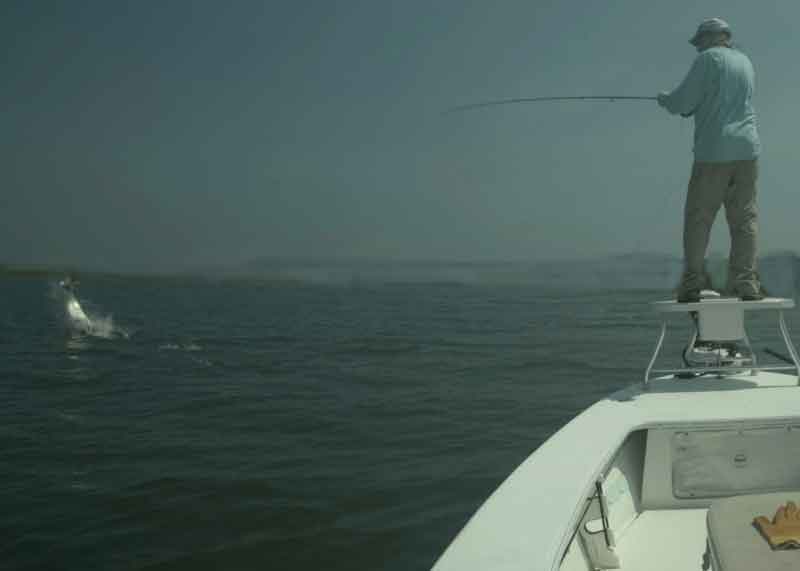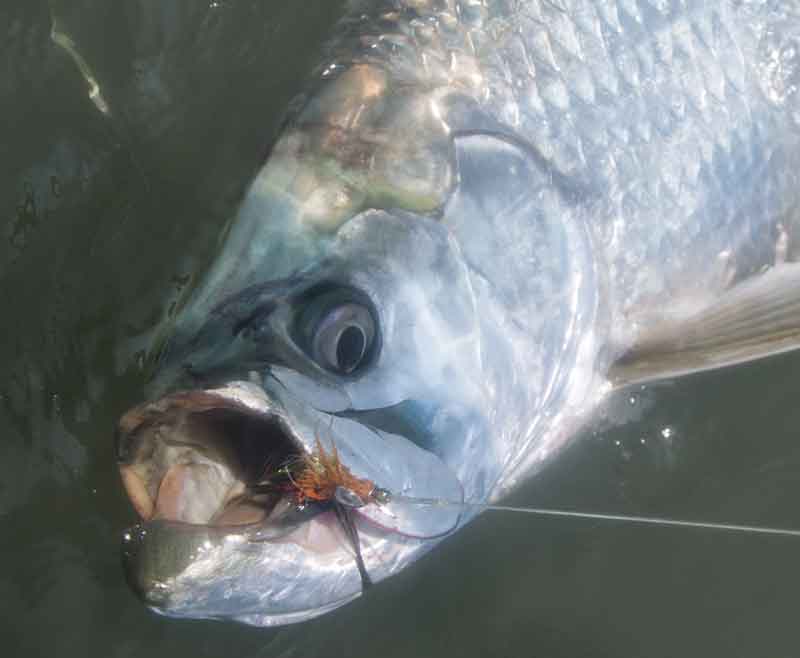In years past, no one who knew the truth would even admit that tarpon visit Virginia each summer. That has changed, as Virginia tarpon are the talk of veteran and hopeful anglers alike. While detailed information is still difficult to obtain, the fishery does exist and it is fascinating – but fragile. To say it is challenging is a vast understatement.

Tarpon, in the genus megalops because of their big eyes, are commonly found from Virginia south through the Gulf of Mexico and the Caribbean to Brazil. They are also found off both coasts of Africa. They spawn at sea and the larvae drift inshore, where they often take up residence in the nastiest waters. Tarpon can breathe air through their swim bladders. This allows the youngsters to live in stagnant mud holes where other predators, especially larger fish, cannot survive. This ability to gulp air also gives adult tarpon a second wind when hooked. They have significant stamina, to say the least, and the get big – very big. The IGFA world all-tackle records show a 286-pound nine-ounce monster.
Tarpon aficionado Barry Truitt, of Machipongo, Virginia, discovered an old Peninsula Enterprise newspaper article that documents a Virginia tarpon caught in August 1936. The fish was caught by accident, near Chincoteague. Claude Rogers, the former director of the Virginia Saltwater Fishing Tournament, is generally credited with catching the first Virginia tarpon intentionally. That was in 1955.
Tarpon migrate up the east coast each spring and return to Florida or the Gulf in the fall. They arrive in Virginia each June and leave by the end of September. Most patrol the remote back-country on the seaside of Virginia's Eastern Shore. However, a few wander into the Chesapeake Bay each year, often in the Mobjack Bay area. Some tarpon veterans believe that the tarpon stay in Virginia until there’s a cold front or two. However, their numbers begin to thin out long before a cold blast arrives, so the shortening of days plays a role in their migration as well.
Nothing is easy when it comes to tarpon. They can be difficult to find, especially in Virginia. Then, you have to get one to bite. Then, the hook has to hold. Only the sharpest hooks will gain purchase in their bony mouths. If you get this far and have hooked one, you still face the long odds of getting the fish to the boat. They fight and jump as hard as any fish that swims.

Fighting a tarpon is visual, with all the jumps. It’s even audible, as their gills rattle when they shake their heads. No other inshore fish puts on such a display.
Almost everyone in Virginia who fishes for tarpon uses conventional gear and bait. Most anglers look for rolling tarpon to choose an area to fish, then put out a few baits at different depths and wait. It’s best to put out no more than two or three rods, as too many lines out can be a problem if you hook a fish. Plus, sharks and rays may be numerous. Most people use 30-pound gear. Many anglers prefer spooling with monofilament line and not braid, as the mono's stretch provides a built-in shock absorber. Leaders should be a few feet of 80- to 100-pound mono. We had a tarpon chew through a 60-pound mono leader once, so don't go lighter. Large circle hooks are attached to the business end of the leader. Any fresh fish can be used as bait. There are also occasions when the fish can be seen, and sight fishing with a fly or lure is possible.
Virginia tarpon anglers normally depart from the ramps at Red Bank, Oyster, or Wise Point (by Fisherman Island). The seaside back-country is not friendly to boaters, especially those who are new to the area. Channels are either not marked, or are incorrectly marked. Day markers that once delineated a channel may now mark marsh. And don't believe that PVC pipes and stakes indicate channels – they usually mark aquaculture or grass beds. On top of all that, large beautiful bays can go completely dry at low tide. I see grounded boats every year, and have hit the bottom countless times myself. Fortunately for the fish, many novice tarpon chasers quit after a few days of countless rays, sharks, sunburn, and insect bites with no tarpon to show for it.
Tarpon appear so powerful and majestic that it can be difficult to believe they are not indestructible. But they can easily be fought too long, to their death, or worn out to the point that they become shark food. If you fight a Virginia tarpon for a few hours you are doing something wrong. Learn how to set a drag and pull hard. Dragging them into the boat is very harmful, and sticking a hand in their gills is fatal. Of course, catching one in Virginia waters is such an accomplishment that anglers naturally want their picture with the fish – but, don't kill it by dragging it into the boat for social media likes. Your angling friends will actually respect you more if you lean over the side, smile with the fish in the water, snap a pic, and let it go. In Florida it’s actually illegal to remove tarpon over 40-inches from the water, and almost all tarpon caught in Virginia are over 40-inches.
The question everyone always asks is where. Exactly where. Where should you go to try and hook up with a Virginia tarpon. The late Bob Hutchinson, once the outdoors editor for the Virginia Pilot and a tarpon fanatic, got asked that question a million times. His answer is perfect, and accurate. “They are everywhere, and they are nowhere.” If you want to give it a try, you will have to start like everyone else... searching on your own for the elusive Virginia tarpon.
-By Kendall Osborne
Sign up here to get the weekly FishTalk Chesapeake Bay and Mid-Atlantic fishing reports in your email inbox, every Friday by noon.